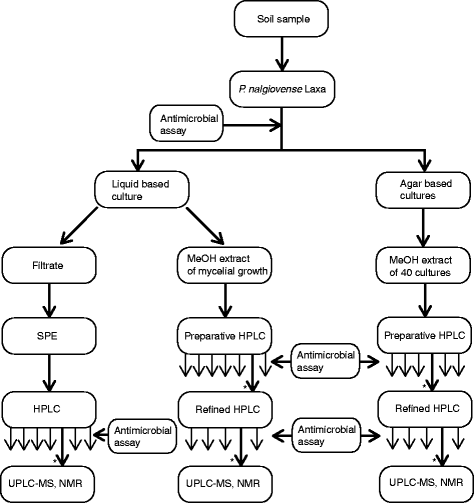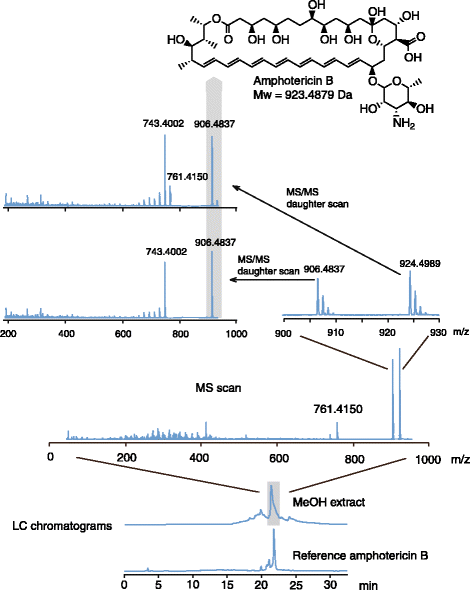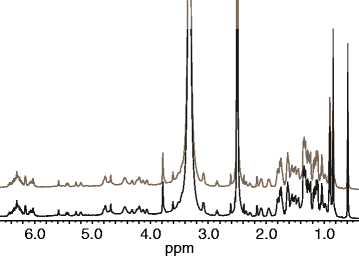Penicillium nalgiovense Laxa isolated from Antarctica is a new source of the antifungal metabolite amphotericin B
- PMID: 28955453
- PMCID: PMC5611601
- DOI: 10.1186/s40694-014-0011-x
Penicillium nalgiovense Laxa isolated from Antarctica is a new source of the antifungal metabolite amphotericin B
Abstract
Background: The need for new antibiotic drugs increases as pathogenic microorganisms continue to develop resistance against current antibiotics. We obtained samples from Antarctica as part of a search for new antimicrobial metabolites derived from filamentous fungi. This terrestrial environment near the South Pole is hostile and extreme due to a sparsely populated food web, low temperatures, and insufficient liquid water availability. We hypothesize that this environment could cause the development of fungal defense or survival mechanisms not found elsewhere.
Results: We isolated a strain of Penicillium nalgiovense Laxa from a soil sample obtained from an abandoned penguin's nest. Amphotericin B was the only metabolite secreted from Penicillium nalgiovense Laxa with noticeable antimicrobial activity, with minimum inhibitory concentration of 0.125 μg/mL against Candida albicans. This is the first time that amphotericin B has been isolated from an organism other than the bacterium Streptomyces nodosus. In terms of amphotericin B production, cultures on solid medium proved to be a more reliable and favorable choice compared to liquid medium.
Conclusions: These results encourage further investigation of the many unexplored sampling sites characterized by extreme conditions, and confirm filamentous fungi as potential sources of metabolites with antimicrobial activity.
Keywords: Amphotericin B; Antarctica; Penicillium nalgiovense Laxa.
Figures




Similar articles
-
Bioactive metabolites of Streptomyces misakiensis display broad-spectrum antimicrobial activity against multidrug-resistant bacteria and fungi.Front Cell Infect Microbiol. 2023 Apr 24;13:1162721. doi: 10.3389/fcimb.2023.1162721. eCollection 2023. Front Cell Infect Microbiol. 2023. PMID: 37168394 Free PMC article.
-
EPICO 3.0. Empirical antifungal therapy in critically-ill hematology patients.Rev Iberoam Micol. 2016 Oct-Dec;33(4):206-215. doi: 10.1016/j.riam.2016.06.002. Epub 2016 Oct 15. Rev Iberoam Micol. 2016. PMID: 27751781
-
Antagonistic activity of the food-related filamentous fungus Penicillium nalgiovense by the production of penicillin.Appl Environ Microbiol. 1994 Sep;60(9):3401-4. doi: 10.1128/aem.60.9.3401-3404.1994. Appl Environ Microbiol. 1994. PMID: 7944371 Free PMC article.
-
Liposomal amphotericin B: a review of its use as empirical therapy in febrile neutropenia and in the treatment of invasive fungal infections.Drugs. 2009;69(3):361-92. doi: 10.2165/00003495-200969030-00010. Drugs. 2009. PMID: 19275278 Review.
-
Amphotericin B: spectrum and resistance.J Antimicrob Chemother. 2002 Feb;49 Suppl 1:7-10. doi: 10.1093/jac/49.suppl_1.7. J Antimicrob Chemother. 2002. PMID: 11801575 Review.
Cited by
-
Biopharmaceuticals from microorganisms: from production to purification.Braz J Microbiol. 2016 Dec;47 Suppl 1(Suppl 1):51-63. doi: 10.1016/j.bjm.2016.10.007. Epub 2016 Oct 26. Braz J Microbiol. 2016. PMID: 27838289 Free PMC article. Review.
-
Enhancing laccase production by white-rot fungus Funalia floccosa LPSC 232 in co-culture with Penicillium commune GHAIE86.Folia Microbiol (Praha). 2019 Jan;64(1):91-99. doi: 10.1007/s12223-018-0635-y. Epub 2018 Aug 6. Folia Microbiol (Praha). 2019. PMID: 30084087
-
Amphotericin B biosynthesis in Streptomyces nodosus: quantitative analysis of metabolism via LC-MS/MS based metabolomics for rational design.Microb Cell Fact. 2020 Jan 31;19(1):18. doi: 10.1186/s12934-020-1290-y. Microb Cell Fact. 2020. PMID: 32005241 Free PMC article.
-
Liposomes: Biomedical Applications.Chonnam Med J. 2021 Jan;57(1):27-35. doi: 10.4068/cmj.2021.57.1.27. Epub 2021 Jan 25. Chonnam Med J. 2021. PMID: 33537216 Free PMC article. Review.
-
Antifungal activity of cyclopaldic acid from Antarctic Penicillium against phytopathogenic fungi.3 Biotech. 2023 Nov;13(11):374. doi: 10.1007/s13205-023-03792-9. Epub 2023 Oct 17. 3 Biotech. 2023. PMID: 37860288 Free PMC article.
References
-
- Kumarasamy KK, Toleman MA, Walsh TR, Bagaria J, Butt F, Balakrishnan R, et al. Emergence of a new antibiotic resistance mechanism in India, Pakistan, and the UK: a molecular, biological, and epidemiological study. Lancet Infect Dis. 2010;10:597–602. doi: 10.1016/S1473-3099(10)70143-2. - DOI - PMC - PubMed
LinkOut - more resources
Full Text Sources
Other Literature Sources

